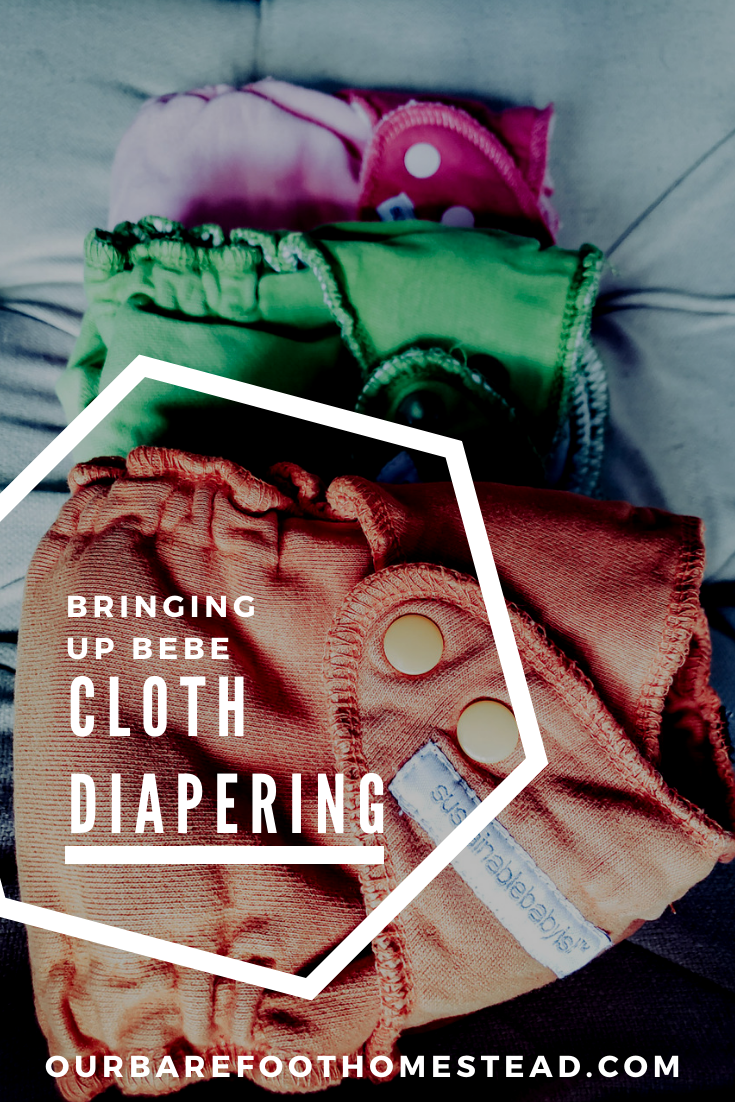We’re fully back in the throes of baby rearing here on our little homestead. And that means we’re back at this cloth diapering business a mere 7 months after we potty trained our first.
When I was first looking into cloth diapering, I read as many resources as I could trying to wrap my mind around all the options and all the whys. I loved hearing first hand accounts of what worked and what didn’t. So I’m going to share mine here, for the next curious mama who would like to know a little more.
This won’t be an exhaustive list of options, pros, cons, etc. There are plenty of those out there. This is just my experience with cloth diapering.
Identifying the why is probably the most important thing you can do when starting a cloth diaper journey. We like cloth for two reasons: economy and environment. And, in all honesty, economy outweighs environment for us.
That means all of our decisions about cloth diapering needed to be made with these two goals in mind.
Newborns are tiny. They just are. So few diapers other than newborn size fit them right away. Buying a whole stash of newborn diapers to use for just a couple weeks didn’t fit with my goals of economy. So I elected to wait out the first few weeks using disposables (or “sposies” as they are known in cloth circles). This also saved me a lot of work, since newborns go through so many diapers!
There are a lot of options out there for cloth diapering: all-in-ones, pockets, fitteds, flats, etc. etc. etc.
We settled on prefolds and covers for both ease of use and frugality. I didn’t have the time to stuff a gazillion pocket diapers when they came out of the wash. I couldn’t afford the fancy all-in-ones. Fitteds were too expensive for the quantity I would need. Prefolds were the most cost-effective solution I could find.
In selecting my prefolds, I looked for quality and absorbency. I ended up choosing Grovia Bamboo Prefolds and have been very happy with them. I skipped the first size and went with infants to begin. (With my daughter, I pad folded and just folded down the end a bit. With my son, I’ve been doing an angel wing fold and don’t have any extra length.)
In choosing covers, I looked for quality and durability. We ended up selecting Thirsties Duo Wraps. They do require buying two sizes of covers, but it just didn’t seem like a single size cover would work on a tiny infant and a 2-year-old. I like the snap version for a few reasons. The snaps tend to hold up better over time, I HATE washing things with “hook and loop” (Velcro), and they have better resale value once I’m done with them.
One of the things I liked best about the Duo Wrap is the double gusset along the leg. My husband and I are both long and narrow, and I had a feeling our littles would be too. As long as these are put on correctly (without any of the prefold sticking out), I haven’t had an issue with leakage or wicking onto clothes during the day.
I found really good luck searching my local cloth diaper swap BST on Facebook. I also checked other places for secondhand diapers, like clothdiapertrader.com or my local OfferUp app. There are also special BST groups on Facebook just for the brands you like. Finding these things secondhand saved us a TON of money. I highly recommend.
Other places to look for diaper supplies include Nicki’s Diapers and Green Mountain Diapers. Just a tip, the Black Friday deals can be great!
For nighttime, I needed a little more than what the bamboo prefolds and covers could provide. So I looked to wool.
I ended up purchasing a handful of Sustainablebabyish (now Sloomb) Organic Bamboo Fitteds, just enough for one each night between washing. And I invested in some Sloomb Wool Covers.
Wool does have some extra care needed (like hand washing in wool wash and lanoing), but it works. I’ve been very happy with our wool purchases. They are expensive though, so I try to keep them minimal.
We also use cloth swim diapers. I prefer the AMP Swim Diaper, a brand out of Canada. They work great, come in two sizes, and snap/unsnap easily in case of a needed diaper change (I REALLY didn’t like the idea of having to pull off a dirty diaper). I suggest having two of these, as you would hate to finally get to the pool, just to have a dirty diaper and have to go home because you don’t have a replacement.
I also bought a few extras here and there. I found a good price on some Workhorse Fitteds from Green Mountain Diapers. These were great for giving someone with less experience (husband, babysitter, grandparent, etc.) an easy diaper to use before trying the prefolds. I have a couple hemp diapers on hand and some nice doublers if needed for more absorbancy.
For storing used diapers, I bought Planetwise Pail Liners (2) and Wet/Dry Bags (2). These held up great and worked exactly as they should.
I purchased two sets of Grovia Wipes. I like how thick they are (terrycloth) as opposed to thinner flannel wipes. But that, as with everything here, is a personal preference. I bought a secondhand wipe warmer from a thrift store to put them in, and I make my own wipe solution (2 cups of water (distilled or boiled), a spoonful of coconut oil, and a dollop of baby wash). Then I pour the solution over the wipes in the warmer and I’m all set.
I found someone selling a diaper sprayer secondhand. And I purchased a few Snappis, some cloth-friendly rash cream, and I was ready to start.
One big question out there is how many diapers?? This is entirely dependent on how often you can or want to do laundry. Every other day? Good for you! As a working mom, I wasn’t going to be able to do laundry nearly that often, so I bought a few more. But I started small and added as I saw need (in other words, when we started running out between washings).
Another intimidating question a lot of people have is on wash routines. Mine is pretty simple. When I’m ready, I throw the diapers, wipes, pail liner, etc. in the washing machine. I wash on hot, the appropriate size load, with Tide Free and Gentle Powder (FYI, I find the best price for this on Jet.com). Then I set it to regular agitation, about mid-length cycle.
When that is finished, I peel everything off the sides of the washing machine drum and add in additional laundry. I usually add in baby/toddler laundry, but also things like washcloths, socks, etc. could go in. Anything smaller than a baby blanket. And I wash using my regular settings (for instance, cold water).
I hang dry the covers to help extend the life of the elastics, as that is always the first thing to go. (Note, to not put pressure on the elastics, they should be hung with two clothespins, one on the front of the diaper, one on the back, so they are hanging “sideways” rather than vertically.) The rest goes in the dryer on low.
If I have any stains, I take the wet items and hang them in the sun. The sun does miracles!
For the wool, I like to use Soak and I use pharmaceutical grade lanolin (that I also use for breastfeeding). After carefully hand washing in the Soak and rinsing (all in tepid water), I place on a towel and roll them up and press the water out. Then I give them a lano bath (tepid water, lanolin, and emulsifying cube). I roll them in the towel again and hang dry inside out of the sun. Because of the antimicrobial properties of wool, they don’t have to be washing super often.
Cloth diapering can take some time to get used to, but it isn’t much more difficult than anything else baby related and it can be very rewarding, financially and environmentally. Any questions for me? Drop them below!


Copyright Holly Combs and Our Barefoot Homestead

